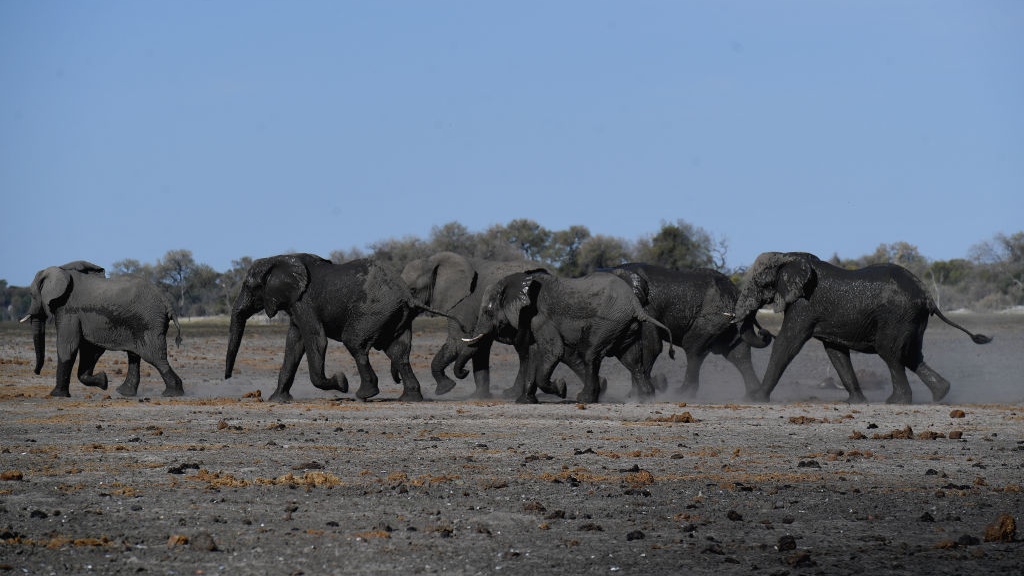Scientists and conservationists expressed alarm after hundreds of elephants were found mysteriously dead in Botswana, according to The Guardian.
Phys.org reported that Botswana has about 135,000 elephants within its borders, representing nearly one-third of Africa's entire elephant population. But in May, the country's tourism industry told the news outlet that it found a dozen elephants dead in the famous Okavango Delta.
"So far, veterinary officers have ruled out the possibility of poaching because all carcasses of the elephants were found intact," Oduetse Koboto, the tourism ministry's acting permanent secretary, said in a statement in May.
The problem has now grown dramatically, with hundreds more elephants being found dead in recent weeks, BBC News reported. While many immediately pointed to poaching as a potential reason, this theory was quickly debunked because the prized tusks were still on the elephants.
Also, poachers typically use cyanide to kill the elephants, causing other animals that feed on the carcasses to die as well. This did not happen in this specific instance, leading conservationists to question what is actually killing the elephants.
By the end of May, a dozen dead elephants morphed into 169. By the middle of June, that figure doubled.
Sources told The Guardian that hundreds of elephants were found dead around specific watering holes. The Botswana government has struggled to test the elephants because of the coronavirus pandemic, and the Tourism Ministry told the newspaper that it would take weeks before the tests came back.
According to eyewitnesses, some of the elephants were seen wandering in circles before they died, which is strange behavior not typical of the animal. This may indicate that it is a neurological condition that is killing the elephants, the sources said.
“If you look at the carcasses, some of them have fallen straight on their face, indicating they died very quickly. Others are obviously dying more slowly, like the ones that are wandering around. So it’s very difficult to say what this toxin is,” said Dr. Niall McCann, the director of conservation at UK-based charity National Park Rescue.
There are no observable patterns in terms of age or sex, confusing conservationists even more. Local residents in Botswana have said there are dozens of other elephants who look sick and weak, and conservationists believe the current death numbers are an undercount.
The Guardian reported that other countries nearby have not reported anything similar, leaving scientists questioning what could be the cause of the mass deaths.
“Several live elephants that we observed appeared to be weak, lethargic and emaciated. Some elephants appeared disorientated, had difficulty walking, showed signs of partial paralysis or a limp. One elephant was observed walking in circles, unable to change direction although being encouraged by other herd members," a report from Elephants Without Borders said, according to Reuters.
Dr. Cyril Taolo, acting director for Botswana’s department of wildlife and national parks, told The Guardian: “We are aware of the elephants that are dying. Out of the 350 animals we have confirmed 280 of those animals. We are still in the process of confirming the rest."
“We have sent [samples] off for testing and we are expecting the results over the next couple of weeks or so. The COVID-19 restrictions have not helped in the transportation of samples in the region and around the world. We’re now beginning to emerge from that and that is why we are now in a position to send the samples to other laboratories,” Taolo said.
He told AFP that about 356 elephants are reported dead and that samples have been sent to South Africa, Zimbabwe and Canada for tests.
McCann told BBC News that the dead elephants were initially found after flights were conducted over the delta, which is home to about 15,000 elephants.
A catastrophic die-off of elephants is happing in northern Botswana, and no one knows why. It’s vital that a team of independent experts visit and sample the carcasses before any more elephants die, or this spills over into the local human population. https://t.co/sfxfSOHDkd
— Niall McCann (@NiallPMcCann) July 1, 2020
"They spotted 169 in a three-hour flight. To be able to see and count that many in a three-hour flight was extraordinary. A month later, further investigations identified many more carcasses, bringing the total to over 350. This is totally unprecedented in terms of numbers of elephants dying in a single event unrelated to drought. It is only elephants that are dying and nothing else. If it was cyanide used by poachers, you would expect to see other deaths," McCann said.
Despite Taolo's statement about the coronavirus pandemic complicating efforts to figure the mystery out, McCann and Mary Rice, executive director of the Environmental Investigation Agency in London, leveled harsh criticism at the Botswana government for not moving faster to address the issue and for not letting British groups handle the testing.
McCann also implied in his interview with BBC News that there was real concern about the unknown disease or ailment potentially affecting humans, considering the elephants were dying near water sources.
Although it has not been officially confirmed that COVID-19 originated in animals before jumping over to humans, McCann told BBC News that there was potential for something similar to happen in this instance.
"Yes, it is a conservation disaster — but it also has the potential to be a public health crisis," he said.
